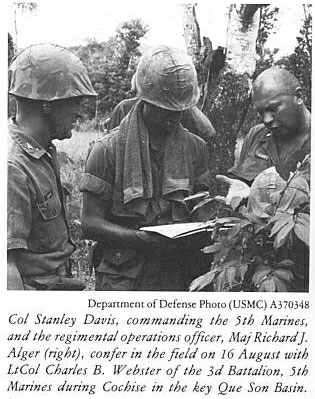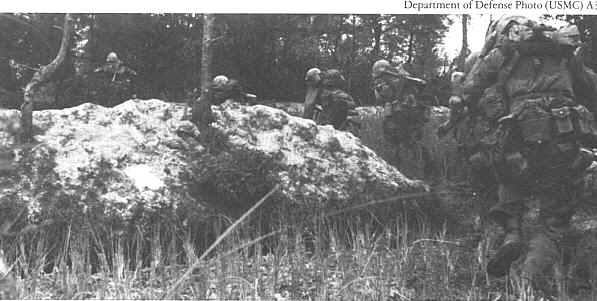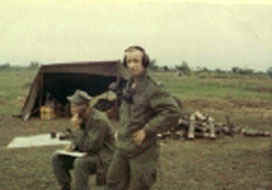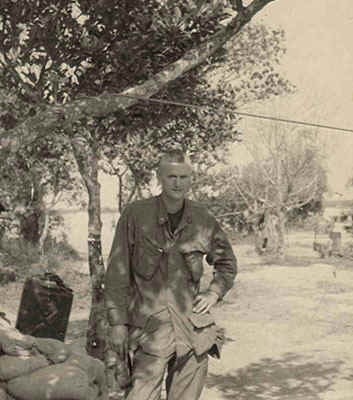
Operation
COCHISE This is not an official USMC combat operations page, but our personal attempt to recover as much info as we can about the operations participated in by the 3rd Battalion, 5th Marines in Vietnam. We will be posting recollections and pictures (when available) from Marines and FMF Corpsmen who participated in Operation COCHISE. Comments are from informal emails, phone calls, and other correspondence to Brad and I. All related pictures and information is greatly appreciated. "Continuing
Operations Against the 2d NVA Division" Information photocopied from "U.S. Marines in Vietnam - Fighting the North Vietnamese 1967" by Major Gary L, Telfer, USMC, Lieutenant Colonel Lane Rogers USMC and V. Keith Fleming, Jr. One of the "U.S. Marines in Vietnam Operational History" Series.
During June allied units intensified operations against elements of the 2d NVA Division and Viet Cong units in the southern three provinces of I Corps. The enemy continued to pump replacements into the region in a determined effort to regain control of the area, particularly the Que Son Basin. The allied forces, in greater numbers and with increased firepower, thwarted each Communist move as it developed. As a result of continuing enemy defeats, the pacification program began to show positive results as demonstrated by its expansion into virgin territory. As July began, the 1st and 7th Marines, both from the 1st Division, which Major General Donn J. Robertson still commanded, were operating in the densely populated area around Da Nang. Two battalions of the 5th Marines continued operations against elements of the 2d NVA Division in the Que Son Basin, while the other battalion of the 5th Marines, the 2d, provided security for the An Hoa industrial complex and Nong Son coal mine southwest of Da Nang. During the night of 14 July, enemy rocket units moved out of "Happy Valley," southwest of Da Nang, and established six firing positions, divided into two clusters of three positions each. Each firing position contained six individual launcher sites. Shortly after midnight the enemy fired their rockets at the airfield' within five minutes 50 projectiles hit the base. Marines responded swiftly to the first volley. Almost instantly, a number of friendly units reported the firing and three minutes after the enemy launched the rockets an Air Force plane attacked one of the sites. At the same time, artillery units plotted the launch site locations and commenced firing at both the sites and the probable escape routes. This rapid reply by supporting arms was exemplary, but it was only a countermeasure and not a solution to the problem of defending the Da Nang complex against the new, long-range threat. In the attack, the rockets destroyed 10 aircraft, 13 barracks, and a bomb dump and damaged 400 more aircraft. Eight Americans died and another 176 suffered wounds. The Communists had not only succeeded in destroying a large quantity of material, but the resulting fires provided visible evidence of a successful attack to the 300,000 people living around Da Nang. That the VC carried out the attack successfully, while the Marines and ARVN forces had been actively trying to prevent it, vastly increased its propaganda value. The 14 July attack forced immediate adjustments of III MAF's defense of the airfield. III MAF extended the rocket belt to include the space between two radii of 12,000 and 8,000 meters, the maximum ranges from which the VC could launch both 140mm and 122mm rockets. The new belt also included the most likely areas of penetration by enemy launching units. The Marines established a centralized control system for all aspects of the counter-rocket effort and increased their patrols and overflights. They also instituted a waterway control plan which included an 1800-0600 movement curfew on all streams within the belt. Deep reconnaissance patrols along the enemy's approach routes outside the belt increased by 40 percent. In addition, the 1st Marine Division developed an elaborate psychological operations (PsyOps) campaign to counter the threat, including the offer of 10,000-piastre rewards for information on rockets, location of caches, and routes used to bring rockets into the Da Nang area. On a day-to-day basis, the division allocated more than 90 percent of its PsyOps assets to this program. While the Communist rocket gunners were annoying the Ca Nang TAOR, intelligence agencies reported that the 3rd NVA Regiment had moved into northern Quang Tin Province during late July. Intelligence also indicated the headquarters of the 1st VC Regiment also had moved from Quang Ngai Province to a new location east of Hiep Duc in the Que Son Basin. Reacting to these reports, on 9 August General Robertson reactivated Task Force X-Ray, again under the command of his assistant division commander, Brigadier General Foster C. La Hue. General LaHue received orders to strike the enemy wherever possible within the Que Son Basin and surrounding hills, with emphasis on the Hiep Duc area which intelligence officers believed contained the 2d NVA Division's headquarters and logistic base. For this operation, code named COCHISE, General LaHue's Task Force X-Ray controlled the 1st and 3rd Battalions of Colonel Stanley Davis' 5th Marines and Lieutenant Colonel Alfred I. Thomas' BLT 1/3 from SLF Alpha. General LaHue's concept of operations for COCHISE consisted of three phrases. The first phase involved the insertion of the two 5th Marines battalions south of Nui Loc Son outpost between the tactical elements of the 2d NVA Division and its suspected logistic base. The two battalions were to drive east toward friendly blocking positions and eliminate communist tactical forces in the vicinity of the Communist tactical forces in the vicinity of the logistic installations. Phase II called for a helilift of two battalions into the suspected enemy base areas, and the third phase a two-battalion sweep from the Hiep Duc region northeast to Que Son.
Two battalions of the 5th Marines, the 1st and 3rd, remained in the Que Son Basin after the arrival at Chu Lai of Army units of Task Force Oregon. Marines of the 3rd Battalion maneuver under fire on 21 July wile in contact with units of 2nd NVA Division. 11 August South of the Cochise area of operation the 2d ARVN Division was about to conduct companion operation Lien Ket 112; its concept resembled Cochise. Two ranger battalions were to be helilifted into landing zones southeast of Hiep Duc and sweep eastward, while three battalions of the 6th ARVN Regiment occupied blocking positions west of Tam Ky. Both operations began early on the morning of 11 August. 12 August The ARVN rangers made the first significant contact. On the morning of the 12th, three battalions of the 21st NVA Regiment attacked the rangers. Heavy fighting continued throughout the day and by 1700 the rangers reported heavy casualties. Dangerously low on ammunition, with darkness approaching, and with no sign of a letup on the part of the enemy, the rangers requested an emergency re-supply. At 1730, a CH-46 could not land in the contested zone. The pilot, Captain Jack H. McCracken, well aware of what would happen to the rangers without ammunition decided to try to deliver his cargo anyway. He ordered his crew chief, Corporal James E. Bauer, to stack the ammunition on the rear ramp. Captain McCracken nosed over his helicopter and raced for the landing zone. McCracken then hovered 30 feet over the zone, and Corporal Bauer lowered the ramp and most of the ammunition dropped into the zone. While repeated enemy small arms hits shook the helicopter, Corporal Bauer kicked out the rest of the ammunition. As the last box dropped, enemy bullets severely damaged the helicopter, but McCracken's re-supply permitted the rangers to continue the battle. At 2300, the NVA units finally pulled back, leaving 197 bodies behind. the ranger losses also had been heavy, 81 killed and 153 wounded. During the next three days, there were numerous encounters with small VC elements. 16 August On the night of 16 August, enemy units twice attempted to infiltrate BLT 1/3s night positions, but turned back in the face of small arms and artillery fire, leaving 36 bodies behind. The next morning, Lieutenant Colonel Joseph A. Nelson, commanding officer of VMO-6, in a UH-1E gunship, was escorting re-supply helicopters when he sighted more than 50 VC in the open. The The VMO-6 commander expended all of his ordnance in the process of fixing the enemy group in place. He then directed a fixed-wing mission against the target. Meanwhile, a company of Lieutenant Colonel Charles B. Webster's 3rd Battalion, 5th Marines moved into assault positions under cover of the airstrike. After Webster's attack, a sweep of the area located 40 VC bodies. Total Marine casualties totaled only three wounded. On the afternoon of the 18th, the first phase of Operation COCHISE ended and Task Force X-Ray withdrew Webster's battalion. The next morning helicopters lifted the remaining two battalions into the Hiep Duc area for Phase II. Though the Marines anticipated a sizable enemy force in this region, there was little contact and the operation turned into a bush-beating effort. The final phase of COCHISE began on the 25th and continued until 28 August. Enemy contact during the last three days consisted of sniper fire and booby traps. Final casualty results for COCHISE included 156 enemy killed and 13 captured. Marine casualties were light in comparison, 10 killed and 93 wounded. Vietnamese Operation Lien Kit 112 accounted for 206 NVA killed, 12 prisoners, and 42 weapons seized. ARVN losses were more severe than Marine casualties during COCHISE, 83 killed, 174 wounded, and 3 missing. Although these operations forced a major portion of the 2d NVA Division to withdraw, III MAF had no illusions of the enemy abandoning the densely populated, rice-bearing lands of the Que Son Basin. COCHISE and Lien Ket 112 had been tactical victories, but the 2d NVA Division had suffered only a reverse, not a defeat. ************************************************ 3rd Battalion, 5th Marines
Was proud to serve with Captain McElroy; Gunny Denny Dinota and a bunch of other great Marines during Operation Union; Union II; Cochise; Swift; and several smaller operations. Received the Silver Star for actions in UNION. Semper fi, Byron.
Joe
Bowers, 1st Platoon M/3/5 **********************************************************
|



